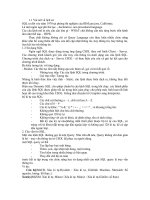Ngôn ngữ Assembly.doc
Bạn đang xem bản rút gọn của tài liệu. Xem và tải ngay bản đầy đủ của tài liệu tại đây (50.76 KB, 3 trang )
IBM Personal Computer Assembly
Language Tutorial
Joshua Auerbach
Yale University
Yale Computer Center
175 Whitney Avenue
P. O. Box 2112
New Haven, Connecticut 06520
Installation Code YU
Integrated Personal Computers Project
Communications Group
Communications and Data Base Division
Session C316
This talk is for people who are just getting started with the PC MACRO Assembler. Maybe you are just contemplating
doing some coding in assembler, maybe you have tried it with mixed success. If you are here to get aimed in the right
direction, to get off to a good start with the assembler, then you have come for the right reason. I can't promise you'll get
what you want, but I'll do my best.
On the other hand, if you have already turned out some working assembler code, then this talk is likely to be on the
elementary side for you. If you want to review a few basics and have no where else pressing to go, then by all means
stay.
Why Learn Assembler?
The reasons for LEARNING assembler are not the same as the reasons for USING it in a particular application. But, we
have to start with some of the reasons for using it and then I think the reasons for learning it will become clear.
First, let's dispose of a bad reason for using it. Don't use it just because you think it is going to execute faster. A
particular sequence of ordinary bread-and-butter computations written in PASCAL, C, FORTRAN, or compiled BASIC
can do the job just about as fast as the same algorithm coded in assembler. Of course, interpretive BASIC is slower, but
if you have a BASIC application which runs too slow you probably want to try compiling it before you think too much
about translating parts of it to
another language.
On the other hand, high level languages do tend to isolate you from the machine. That is both their strength and their
weakness. Usually, when implemented on a micro, a high level language provides an escape mechanism to the
underlying operating system or to the bare machine. So, for example, BASIC has its PEEK and POKE. But, the route to
the bare machine is often a circuitous one, leading to tricky programming which is hard to follow.
For those of us working on PC's connected to SHARE-class mainframes, we are generally concerned with three
interfaces: the keyboard, the screen, and the communication line or lines. All three of these entities raise machine
dependent issues which are imperfectly addressed by the underlying operating system or by high level languages.
Sometimes, the system or the language does too little for you. For example, with the asynch adapter, the system provides
no interrupt handler, no buffer, and no flow control. The application is stuck with he responsibility for monitoring that
port and not missing any characters, then deciding what to do with all errors. BASIC does a reasonable job on some of
this, but that is only BASIC. Most other languages do less.
Sometimes, the system may do too much for you. System support for the keyboard is an example. At the hardware level,
all 83 keys on the keyboard send unique codes when they are pressed, held down, and released. But, someone has
decided that certain keys, like Num Lock and Scroll Lock are going to do certain things before the application even sees
them and can't therefore be used as ordinary keys. Sometimes, the system does about the right amount of stuff but does it
less efficiently then it should. System support for the screen is in this class. If you use only the official interface to the
screen you sometimes slow your application down unacceptably. I said before, don't use assembler just to speed things
up, but there I was talking about mainline code, which generally can't be speeded up much by assembler coding. A
critical system interface is a different matter: sometimes we may have to use assembler to bypass a hopelessly inefficient
implementation. We don't want to do this if we can avoid it, but sometimes we can't.
Assembly language code can overcome these deficiencies. In some cases, you can also overcome these deficiencies by
judicious use of the escape valves which your high level language provides. In BASIC, you can PEEK and POKE and
INP and OUT your way around a great many issues. In many other languages you can issue system calls and interrupts
and usually manage, one way or other, to modify system memory. Writing handlers to take real-time hardware interrupts
from the keyboard or asynch port, though, is still going to be a problem in most languages. Some languages claim to let
you do it but I have yet to see an acceptably clean implementation done that way.
The real reason while assembler is better than "tricky POKEs" for writing machine-dependent code, though, is the same
reason why PASCAL is better than assembler for writing a payroll package: it is easier to maintain.
Let the high level language do what it does best, but recognize that there are some things which are best done in
assembler code. The assembler, unlike the tricky POKE, can make judicious use of equates, macros, labels, and
appropriately placed comments to show what is really going on in this machine dependent realm where it thrives.
So, there are times when it becomes appropriate to write in assembler; given that, if you are a responsible programmer or
manager, you will want to be "assembler-literate" so you can decide when assembler code should be written.
What do I mean by "assembler-literate?" I don't just mean understanding the 8086 architecture; I think, even if you don't
write much assembler code yourself, you ought to understand the actual process of turning out assembler code and the
various ways to incorporate it into an application. You ought to be able to tell good assembler code from bad, and
appropriate assembler code from inappropriate.
Steps to becoming ASSEMBLER-LITERATE
1. Learn the 8086 architecture and most of the instruction set. Learn what you need to know and ignore what you don't.
Reading: The 8086 Primer by Stephen Morse, published by Hayden. You need to read only two chapters, the one on
machine organization and the one on the instruction set.
2. Learn about a few simple DOS function calls. Know what services the operating system provides. If appropriate,
learn a little about other systems too. It will aid portability later on. Reading: appendices D
and E of the PC DOS manual.
3. Learn enough about the MACRO assembler and the LINKer to write some simple things that really work. Here, too,
the main thing is figuring out what you don't need to know. Whatever you do, don't study the sample programs
distributed with the assembler unless you have nothing better!
4. At the same time as you are learning the assembler itself, you will need to learn a few tools and concepts to properly
combine your assembler code with the other things you do. If you plan to call assembler subroutines from a high level
language, you will need to study the interface notes provided in your language manual. Usually, this forms an appendix
of some sort. If you plan to package your assembler routines as .COM programs you will need to learn to do this. You
should also learn to use DEBUG.
5. Read the Technical Reference, but very selectively. The most important things to know are the header comments in
the BIOS listing. Next, you will want to learn about the RS 232 port and maybe about the video adapters.
Notice that the key thing in all five phases is being selective. It is easy to conclude that there is too much to learn unless
you can throw away what you don't need. Most of the rest of this talk is going to deal with
this very important question of what you need and don't need to learn in each phase. In some cases, I will have to leave
you to do almost all of the learning, in others, I will teach a few salient points, enough, i hope, to get you started. I hope
you understand that all I can do in an hour is get you started on the way.
Phase 1: Learn the architecture and instruction set
The Morse book might seem like a lot of book to buy for just two really important chapters; other books devote a lot
more space to the instruction set and give you a big beautiful reference page on each instruction. And, some of the other
things in the Morse book, although interesting, really
aren't very vital and are covered too sketchily to be of any real help. The reason I like the Morse book is that you can just
read it; it has a very conversational style, it is very lucid, it tells you what you really
need to know, and a little bit more which is by way of background; because nothing really gets belabored to much, you
can gracefully forget the things you don't use. And, I very much recommend READING Morse rather than studying it.
Get the big picture at this point.
Now, you want to concentrate on those things which are worth fixing in memory. After you read Morse, you should
relate what you have learned to this outline.
1. You want to fix in your mind the idea of the four segment registers CODE, DATA, STACK, and EXTRA. This part is
pretty easy to grasp. The 8086 and the 8088 use 20 bit addresses for memory, meaning that they can address up to 1
megabyte of memory. But, the registers and the address fields in all the instructions are no more that 16 bits long. So,
how to address all of that memory? Their solution is to put together two 16 bit quantities like this:
calculation SSSS0 ---- value in the relevant segment register SHL 4
depicted in AAAA ---- apparent address from register or instruction
hexadecimal --------
RRRRR ---- real address placed on address bus
In other words, any time memory is accessed, your program will supply a sixteen bit address. Another sixteen bit
address is acquired from a segment register, left shifted four bits (one nibble) and added to it
to form the real address. You can control the values in the segment registers and thus access any part of memory you
want. But the segment registers are specialized: one for code, one for most data accesses,
one for the stack (which we'll mention again) and one "extra" one for additional data accesses.
Most people, when they first learn about this addressing scheme become obsessed with converting everything to real
20 bit addresses. After a while, though, you get use to thinking in segment/offset form. You tend to get your segment
registers set up at the beginning of the pro-
gram, change them as little as possible, and think just in terms of symbolic locations in your program, as with any
assembly language.
EXAMPLE:
MOV AX,DATASEG
MOV DS,AX ;Set value of Data segment
ASSUME DS:DATASEG ;Tell assembler DS is usable
.......
MOV AX,PLACE ;Access storage symbolically by 16 bit address
In the above example, the assembler knows that no special issues are involved because the machine generally uses the
DS register to complete a normal data reference.
If you had used ES instead of DS in the above example, the assembler would have known what to do, also. In front of
the MOV instruction which accessed the location PLACE, it would have placed the ES segment prefix. This would tell
the machine that ES should be used, instead of DS, to complete the address.
Some conventions make it especially easy to forget about segment registers. For example, any program of the COM
type gets control with all four segment registers containing the same value. This program executes in a simplified 64K
address space. You can go outside this address space if you want but you don't have to.
2. You will want to learn what other registers are available and learn their personalities:





